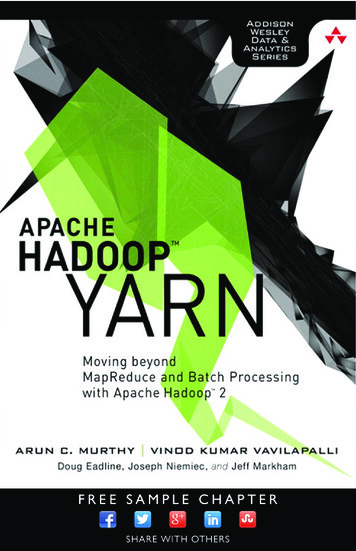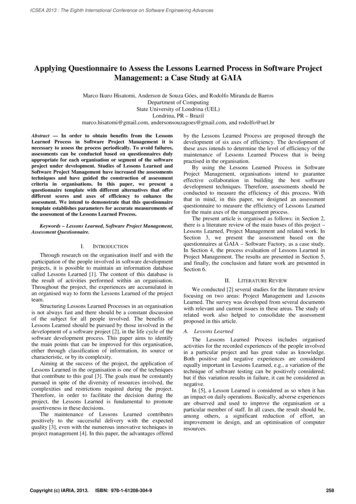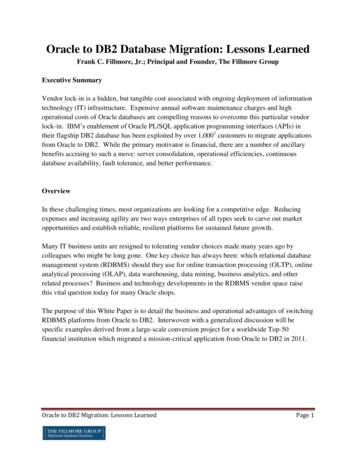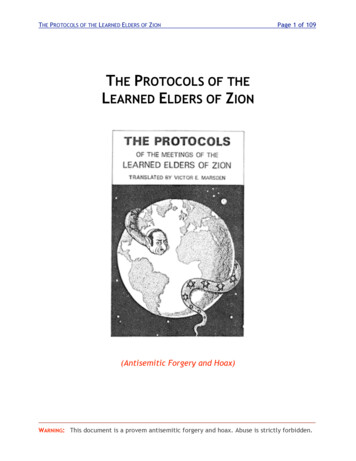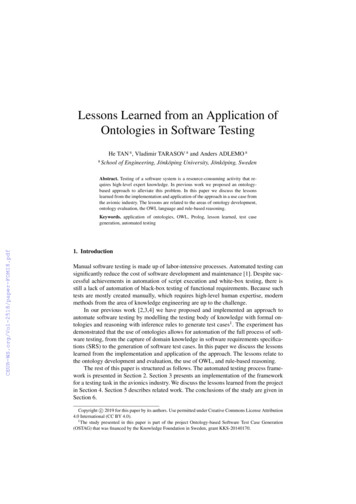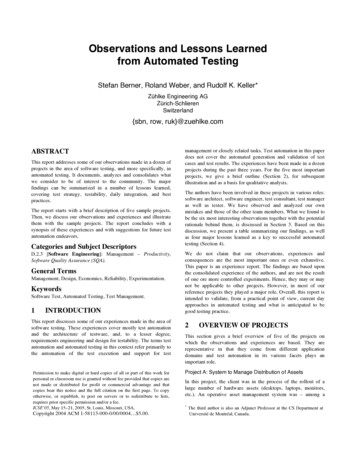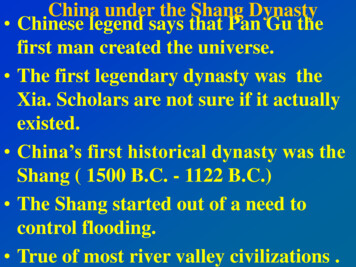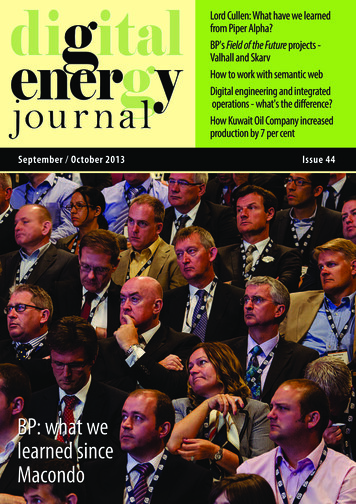
Transcription
Lord Cullen: What have we learnedfrom Piper Alpha?BP's Field of the Future projects Valhall and SkarvHow to work with semantic webDigital engineering and integratedoperations - what's the difference?How Kuwait Oil Company increasedproduction by 7 per centSeptember / October 2013BP: what welearned sinceMacondoIssue 44
Events 2013Improving E&P data managementOffshore remote controlproduction data management - seismic datavalidation - data quality metrics Kuala Lumpur, 08 Oct 2013drilling automation, condition monitoring,well surveillance, production performancemonitoringStavanger, 31 Oct 2013Doing more with offshoreengineering dataManaging seismic field datadesign data - maintenance - PLM corrosion - condition monitoring - sparesWhat data to keep - seismic meta data - datamanagement - reducing the cost of storageKuala Lumpur, 09 Oct 2013Aberdeen, 25 Nov 2013Subsea Instrumentation andControl SystemsOffshore remote controlAberdeen, 26 Nov 2013Are we about to see a revolution insubsea instrumentation, control andcommunications systems?Engineering and project dataStavanger, 29 Oct 2013Aberdeen, 27 Nov 2013Improving engineering datamanagementOptimising the supply chainAberdeen, 28 Nov 2013spares - maintenance - PLM - corrosion condition monitoring - designStavanger, 30 Oct 2013Find out more and reserve your place atwww.d-e-j.com
LeadersBuy lots of tracing paper!There is a major issue with integrating large amounts ofmulti-measurement subsurface data – how can it bedone, if at all?Issue 44For example, let’s suppose you and your team are exploring for shale oil ‘sweet spots’ above one of theworld’s great source rocks, in a tough regulatory environment where a key objective is to ‘make every wellcount’ and drill as few as possible.September / October 2013Digital Energy JournalUnited House, North Road,London, N7 9DP, UKwww.d-e-j.comTel 44 (0)208 150 5292Fax 44 (0)207 251 9179EditorKarl Jefferyjeffery@d-e-j.comConsultant editorDavid BamfordNews editorPanas Kalliantaspdkalliantas@d-e-j.comTel 44 208 150 5291Advertising and sponsorship salesRichard McIntyremcintyre@d-e-j.comTel 44 (0) 208 150 5296ProductionVery Vermilion Ltd.www.veryvermilion.co.ukSocial ns: 250 for personal subscription, 795 for corporatesubscription.E-mail: subs@d-e-j.comWorld-class source rocks: map courtesy of Kimmeridge Energy.At your disposal, you could have: Satellite (SAR) images showing a few active seeps and also possiblepetroleum-related variations in vegetation.FTG (Full tensor gravity gradiometry) data (and some 2D seismic) revealingbasin shape, structural grain.Some passive seismic data showing a small number of zones of ‘anomalousattenuation’.A semi-regional 3D survey, allowing a good geological model to be built.Seismic attributes from said survey.Some information on fracture densities and preferred orientations.Some micro-seep samples.Powerful stuff.Inevitably bringing these diverse data and information together will involve several people, some or all of your team. And it would be great if you could all sitdown and look at the same thing, and form a coherent view of your play.To do this, you will need large amounts of tracing paper and an old-fashionedlight table!Cover Photo: Delegates to the Oil and Gas UK"Piper25" event in Aberdeen in June listen to aspeech by Bob Fryar, Executive Vice President,safety and operational risk, BP, "Advancing GlobalDeepwater Capabilities: Progress and Perspectiveson Safety and Operational Risk Management"Printed by Printo, spol. s r.o., 708 00 Ostrava-Poruba,Czech Republic. www.printo.czBecause I would assert that there is at the moment no other way of integratingall these different types of data and then visualising them together.I wait for somebody to show me that I am wrong!"David Bamford is a past head of exploration at BP and a non executive directorof Tullow Oil"September / October 2013 - digital energy journal3
DĂƌŝŶĞ ĞŝƐŵŝĐDĂƌŝŶĞ ĞŝƐŵŝĐWƌŽĐĞƐƐŝŶŐWƌŽĐĞƐƐŝŶŐ ĞůŝǀĞƌŝŶŐ WŽǁĞƌĨƵů ĞůŝǀĞƌŝŶŐ WŽǁĞƌĨƵů ŽůƵƟ ŽůƵƟ ŽŶƐ ŽŶƐDƵůƟ Ͳ ůŝĞŶƚDƵůƟ Ͳ ůŝĞŶƚ&Ƶůů ƐĞƌǀŝĐĞ ŵĂƌŝŶĞ&Ƶůů ƐĞƌǀŝĐĞ ŵĂƌŝŶĞŐĞŽƉŚLJƐŝĐĂů ĐŽŵƉĂŶLJŐĞŽƉŚLJƐŝĐĂů ĐŽŵƉĂŶLJǁǁǁ͘ĚŽůƉŚŝŶŐĞŽ͘ĐŽŵ ůƉŚŝŶŐĞŽ͘ĐŽŵ ŝŶĨŽΛĚŽůƉŚŝŶŐĞŽ͘ĐŽŵ ĞƌŐĞŶ ,ŽƵƐƚŽŶ ŽŶĚŽŶ KƐůŽ ZŝŽ ĚĞ :ĂŶĞŝƌŽ ŝŶŐĂƉŽƌĞ ĞƌŐĞŶ ,ŽƵƐƚŽŶ ŽŶĚŽŶ KƐůŽ ZŝŽ ĚĞ :ĂŶĞŝƌŽ ŝŶŐĂƉŽƌĞ
ContentsLeadersGetting to integrated operations?What does integrated operations mean, how do you get there, and how does it relate to digital engineering?Jim Crompton and Dutch Holland explain. . . . . . . . . . . . . . . . . . . . . . . . . . . . . . . . . . . . . . . . . . . . . . . . . . . . . . . . . . . . . . . . . . . . . . . . . . . . . . . . . . . . . . . . . . . . . . . . . . . . . . . . . . . . . . . . . . . . . . . . . . .6BP Norge’s “Field of the Future” projectsBP Norge (Norway) has completed 2 "field of the future" projects - on a new production and hotel platform on the Valhall Field, and an FPSO on the Skarv field. Itincludes fibre optic cables, remote condition monitoring together with a remote control room for Valhall" By Eldar Larsen and Paul Hocking, BP Norge AS. . . . . . . .8Kuwait Oil Company - increasing production by 2,500 BPD or about 7%In a pilot digital oilfield project, Kuwait Oil Company managed to increase production from a field by 2,500 barrels of oil per day, or about7% – and also helped staff work more efficiently and reduce downtime. . . . . . . . . . . . . . . . . . . . . . . . . . . . . . . . . . . . . . . . . . . . . . . . . . . . . . . . . . . . . . . . . . . . . . . . . . . . . . . . . . . . . . . . . . .12SubsurfaceOpendTect seismic interpretation software - doubled in 3 yearsdGB Earth Sciences of the Netherlands reports that its "OpendTect" seismic interpretation software has roughly doubled in usage over the past 3 years. . . . . . . . . .14How to standardise well identificationDeveloping a standard system for identifying wells continues to be a constant challenge in the E&P industry, writes Nalin Jena,Upstream Data Manager with Reliance Industries, Mumbai. . . . . . . . . . . . . . . . . . . . . . . . . . . . . . . . . . . . . . . . . . . . . . . . . . . . . . . . . . . . . . . . . . . . . . . . . . . . . . . . . . . . . . . . . . . . . . . . . . . . . . . .141988 Piper Alpha disaster: Aberdeen conference to mark 25 yearsLord Cullen – what have we learned from Piper Alpha?Lord Cullen, who conducted the 13 month government enquiry into the Piper Alpha Disaster, used his keynote speech at the2013 Oil and Gas UK conference to question how much the industry has learned since then. . . . . . . . . . . . . . . . . . . . . . . . . . . . . . . . . . . . . . . . . . . . . . . . . . . . . . . . . . . . . . . . . . . . . . .16BP – what we did after Deepwater HorizonAfter the Deepwater Horizon disaster, BP has re-organised its company so that technical specialists report to a senior technical specialist in the company, not themanager of the asset they are working on, says Bob Fryar, Executive Vice President, Safety and Operational Risk, BP. . . . . . . . . . . . . . . . . . . . . . . . . . . . . . . . . . . . . . . . . . . . . . .Offshore worker’s perspective on safetyTrade Unionist Jake Molloy provided the offshore worker’s perspective on safety at the Piper 25 conference. . . . . . . . . . . . . . . . . . . . . . . . . . . . . . . . . . . . . . . . . . . . . . . . . . . . . . .1821What is a safety case regime?Professor Andrew Hopkins, professor of sociology with Australian National University, explained what a safety case regimeis with offshore – how to make it work – and how safety cases can be improved. . . . . . . . . . . . . . . . . . . . . . . . . . . . . . . . . . . . . . . . . . . . . . . . . . . . . . . . . . . . . . . . . . . . . . . . . . . . . . . . . . .Digital technology to improve safetyThe Oil and Gas UK Piper 25 event in Aberdeen in June had some interesting technology to improve safety in the exhibition. . . . . . . . . . . . . . . . . . . . . . . . . . . . . . . . . . . . . .2226Production OperationsOil and Gas IM – a long way from maturityWhilst oil and gas information technology is getting quite mature, information management is at very early stages of development,reckons Neale Stidolph of AMOR Group. Do you know anyone who likes their IM system? . . . . . . . . . . . . . . . . . . . . . . . . . . . . . . . . . . . . . . . . . . . . . . . . . . . . . . . . . . . . . . . . . . . . . . . . .26Semantic Data in Oil & GasSemantic data standards already exist in the oil and gas industry which can enable you to integrate different types of data together or answerdifficult questions. David Price of TopQuadrant explains how. By David Price, Director of Oil & Gas and Engineering Solutions, TopQuadrant . . . . . . . . . . . . . . . . . . . .29CGI – better ways to work with production dataCompanies are looking to do more and more with their production data – which means that the systems to gather, manage andshare it need to be increasingly sophisticated, says Susan Macleod of CGI. . . . . . . . . . . . . . . . . . . . . . . . . . . . . . . . . . . . . . . . . . . . . . . . . . . . . . . . . . . . . . . . . . . . . . . . . . . . . . . . . . . . . . . . . .Using design software to support the asset lifestyleThere is a growing demand in the oil and gas industry for product lifecycle management software tools, says Dassault Systèmes. . . . . . . . . . . . . . . . . . . . . . . . . . . .3131Managing security throughout developmentA “holistic” approach to security in application development – or managing security throughout the software development process,rather than just at the end – can make a big difference to your security.By Tim Rains, director, Trustworthy Computing Group, Microsoft. . . . . . . . . . . . . . . . . . . . . . . . . . . . . . . . . . . . . . . . . . . . . . . . . . . . . . . . . . . . . . . . . . . . . . . . . . . . . . . . . . . . . . . . . . . . . . . . . . . .33Coriolis flowmeters - monitoring mud flow in drilling"Coriolis" flowmeters, which can monitor fluid flow by sending it through a vibrating tube, are increasingly used for drilling,monitoring mud density and returns flow. . . . . . . . . . . . . . . . . . . . . . . . . . . . . . . . . . . . . . . . . . . . . . . . . . . . . . . . . . . . . . . . . . . . . . . . . . . . . . . . . . . . . . . . . . . . . . . . . . . . . . . . . . . . . . . . . . . . . . . .35September / October 2013 - digital energy journal5
LeadersGetting to integrated operationsWhat does integrated operations mean, how do you get there, and how does it relate to digital engineering?Jim Crompton and Dutch Holland explain.when they should take the plunge. Many others are re-evaluating their IO and DOF programs, having gone off-course or stalled intheir efforts.Dutch HollandJim CromptonJim Crompton is former Senior IT Advisorwith Chevron and Dutch Holland is one ofHouston’stopchangemanagementconsultantsCan Digital Engineering be the key to Integrated Operations (IO)? Or will Digital Engineers have to wait until operations areintegrated to come into their own? Whichcomes first, the chicken or the egg?Although Digital Oil Field and Integrated Operations programs have been around for overten years now, some companies are still stuckat the starting line trying to figure out if andOther companies are listening to the discussions about the Digital Engineer and wondering if there is anything they should do aboutDigital Engineering and how it might fit intothe challenges of the Big Crew Change.An important question to answer upfront iswhether IO is worth it or just another ‘big ideadu jour’.Some operators believe IO is worth it, andhave invested big.For example, Statoil ASA claims that some ofthe benefits of Integrated Operations are asfollows:Improved health, safety and environmentalperformance; more efficient drilling operations; better placement of wells; productioneFieldsSmart FieldsDigital Oil FieldsFields for the Futurewww.ioconf.no9TH INTERNATIONAL CONFERENCE ON INTEGRATEDOPERATIONS IN THE PETROLEUM INDUSTRYTRONDHEIM, NORWAY, 24–25 SEPTEMBER 2013PLENUM 1:,QWHOOLJHQW SHWUROHXP š HOGV DQG LQWHUQDWLRQDO VROXWLRQVSession Chair: Arild N. Nystad, IO Center/NTNUí 2OD %RUWHQ 0RH 0LQLVWHU RI 3HWUROHXP DQG (QHUJ\í 3DDO .LEVJDDUG &(2 6FKOXPEHUJHUí 6RODQJH GD 6LOYD *XHGHV ([HFXWLYH 0DQDJHU ( 3 7HFKQRORJ\ 3HWUREUDVPLENUM 2:,2 FURVV RYHU WHFKQRORJLHV EHWZHHQ 2 * DQG PHGLFLQH6HVVLRQ &KDLU 2OH .OLQJVKHLP &RQRFR3KLOOLSVí èUpdates of Pumps and Pipes – synergies between petroleum engineering andcardiovascular disease”, 3URIHVVRU DQG 0HGLFDO 'LUHFWRU ODQ % /XPVGHQ 7KH 0HWKRGLVW RVSLWDO RXVWRQ í èTelemedicine in O&G in Brazil”, (OLH]HU 6LOYD HDG RI WKH &ULWLFDO &DUH 0HGLFLQH 'HSDUWPHQW DQG WKH è7HOHPHGLFLQH 6HUYLFH RVSLWDO ,VUDHOLWD OEHUW (LQVWHLQé 6DR 3DXORí èThe future of the Operation Room of the Future”, -DQ *XQQDU 6NRJ§V 2SHUDWLRQ 5RRP RI WKH )XWXUH 6W 2ODYV RVSLWDO 7URQGKHLP í èTelemedicine of the Future for O&G”, 'U 0DUW\ .RKQ 06 0' ) &(3 ) &3( &KLHI 0HGLFDO 6FLHQWLVW IRU &DUH 'HOLYHU\ 6\VWHPV ,%0 5HVHDUFKí í í í The terms IO, DOF and Digital Engineer arepeppering the literature, often with overlapping meanings. Perhaps our definitions belowwill be helpful to sort out the moving parts.Integrated Operations - a way of operatingan upstream business to maximize the performance of a business unit. IO coordinatesand unifies the various tasks assigned to theoperating units and vendors involved in orderto maximize performance. Integrated Operations can use digital technology to remove thebarriers between disciplines and companies.Digital Oilfield - an application of digitaltechnology for the improvement of upstreamwork processes in order to better meet the ob-International meeting place for business and scienceWhere Science and Practice meet www.ioconf.noPLENUM 3:7KH IXWXUH RI ,2 ã 7HFKQRORJLFDO RSSRUWXQLWLHV 6HVVLRQ &KDLU 3DXO RFNLQJ %3í “Why some robotic systems prosper for remote operations: Trends in extending humanperception, decisions, and actions through sensors and robots”, OH[ 0RULVRQ &RJQLWLYH 6\VWHPV (QJLQHHULQJ /DERUDWRU\ 7KH 2KLR 6WDWH 8QLYHUVLW\í “How to enable the operational people on the go”, 0LFKDHO 1LFKRODV /RXND 6HFWLRQ HDG XPDQ &HQWULF 7HFKQRORJ\ ,)(í ”Robotics technology as enabler on platform and subsea”, ,QJULG 6FKºOEHUJ 3URMHFW 'LUHFWRU &HQWUH IRU XWRQRPRXV 0DULQH 2SHUDWLRQV DQG 6\VWHPV 026 1718PLENUM 4:%ULQJLQJ LQWHJUDWHG RSHUDWLRQV LQWR WKH UFWLF3DQHO DQG URXQG WDEOH GLVFXVVLRQ 6HVVLRQ &KDLU 9LGDU HSVº 6WDWRLO DQG 0RUWHQ 'DOVPR ,%03DQHO 'LVFXVVLRQ How can IO be used to develop the needed capabilities to operate in the Arctic.í è,FH Ţ RH WUDFNLQJ IRUHFDVWLQJé, 'U 3KLO QQR &RQRFR3KLOOLSVí “Arctic IO by analogy”, UHQW UQW]HQ 6WDWRLO í “Safety challenges in Arctic environments”, %ºUUH -RKDQ 3DDVNH 0DQDJHU 6HFWLRQ IRU 2SHUDWLRQDO 6DIHW\ '19 3 5 //(/ 3URGXFWLRQ DQG SHUIRUPDQFH RSWLPL]DWLRQ6HVVLRQ &KDLU 3URIHVVRU %MDUQH )RVV 17183 5 //(/ 3URDFWLYH PDQDJHPHQW RI VDIHW\ DQG HQYLURQPHQW 6HVVLRQ &KDLU /DUV %RGVEHUJ 6,17()3 5 //(/ ,QWHJUDWHG SODQQLQJ DQG ORJLVWLFV 6HVVLRQ &KDLU QGHUV 9DOODQG 0 5,17(.3 5 //(/ ,2 7HDPZRUN DQG FDSDELOLWLHV 6HVVLRQ &KDLU -RQ .YDOHP ,)(Industrial partners VSHDNHUV IURP LQWHUQDWLRQDO RLO FRPSDQLHV VHUYLFH LQGXVWU\ DQG DFDGHPLFV 9HQXH 5R\DO *DUGHQ RWHO 7URQGKHLP 1RUZD\ ,2 ,QQRYDWLRQ )RUXP 6HSWHPEHU5HJLVWUDWLRQ DQG KRWHO UHVHUYDWLRQ ZZZ LRFRQI QROrganized by Center for Integrated Operations in the Petroleum Industry www.iocenter.no6Definitionsdigital energy journal - September / October 2013 Collaborating international academic partnerswww.fagtrykk.no.optimization; better reservoir and productioncontrol; better monitoring of equipment andmore efficient maintenance; better resourceexploitation and increased recovery; increasedregularity (uptime).
Leadersjectives of the petroleum business. DOF canbe an enabling foundation for Integrated Operations that can help with surveillance, communication, collaboration, real-time data flowand analytics.Digital Engineer - an energy professionalsuited to do the work associated with DOF asit contributes to IO. A Digital Engineer is anoil and gas professional with knowledge andskill in the use of engineering and digital technology to enable major process improvementsthat will result in performance increases inboth physical and business operations.Success at IOAfter the last decade it may be worthwhile tolook at the fundamentals of what it takes to besuccessful in this world of Integrated Operations.Here are four fundamental elements to thinkabout, whether you are just getting started,making a course correction or trying to maintain the momentum of a successful IO program.Treat as emerging technology?Should Integrated Operations be treated as anemerging technology initiative?No. While an emerging technology may beused to help integrate operations, IO, in itstruest sense, is an organizational design initiative.Branding an IO initiative with a “technologyproject” label may become an immediatestumbling block for IO. For example, whenthe subject of the digital oil field is discussed,the context is frequently the difficulty companies are having in getting technology in placethat will be used to generate business value.The topic is frequently talked about in termsof ‘the people problem’ that go along withtechnology integration.After working the technology integrationproblem for many years, we have come tothink about it not in terms of people problemsbut in business terms. An organization has theneed for improving a work process with anidea of increasing productivity, efficiency orbusiness value.Build it and they come?If the digital technology that supports integrated operations works, won’t people beginto work together in an integrated way? If youbuild it, won’t they come?Not necessarily. People work when they are‘ready, willing, and able’ to work together.Available digital technology can certainlyhelp people to be able to work together, butthat ability does not automatically lead to“willingness.”In order to design and deliver the desired workprocess changes for IO, attention must continue to be paid to organizational design. Thedeployment of solutions that enable IntegratedOperations strategy will drive significantchange to some of the basic operational andengineering processes in the oil field.Since the scope and impact can be widespread, the use of organizational engineeringpractices will need to be employed to ensureacceptance of these new tools and processes.To support these changes, senior managementand leaders throughout the organization needto support the investments and cultural changerequired to successfully transform traditionalwork practices.Culture, made up of beliefs, behaviors and relationships, is established by rewards, whetherintentional or accidental. Changing culture,“the way we do things around here”, takes along time, but strong leadership can acceleratethe momentum toward the desired change.Infrastructure, info-structureDo we have to make establishment of infrastructure and info-structure a part of our IOinitiatives?Yes. Operators seeking integrated operationsmust invest in ‘the enablement of IO.’ Todayoperators install sensors, gauges and meterson well heads and selected equipment in orderto collect measurements and test results tosend back to a ‘control room’ environment.These distributed control technologies are mature, especially in plants and producing facilities where we have moved to a ‘closed loop’automated environment. In these examples,companies can move beyond baseline surveillance to control and even towards advancedalarming/ alerting and process automation.But many times a company will find that thereis a significant gap in their automation,telecom
speech by Bob Fryar, Executive Vice President, s af e ty nd op r i lk ,BP "A v c gG b Deepwater Capabilities: Progress and Perspectives on Safety and Operational Risk Management" S ep tm b r/Oc o2013- d i g alnyj u Wor
